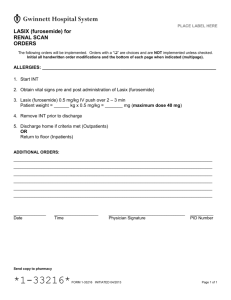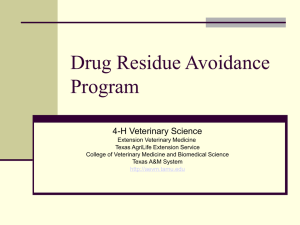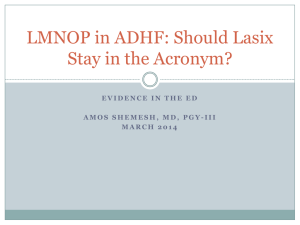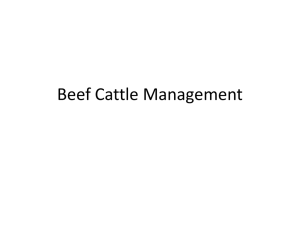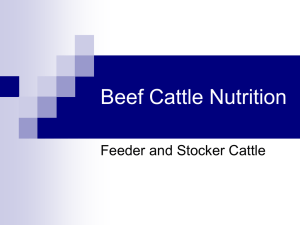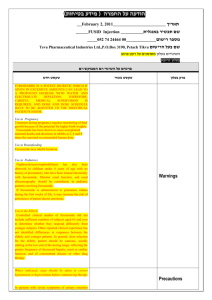proper usage of drugs, chemicals and feed additives in food animals
advertisement
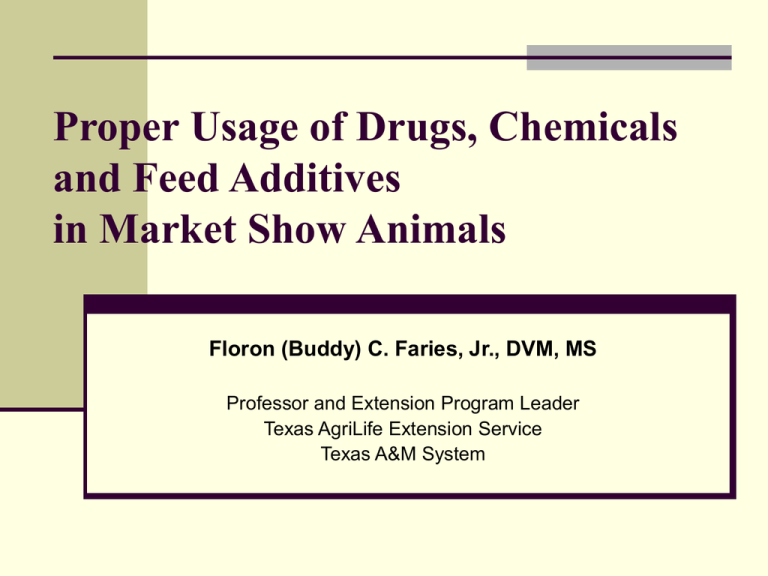
Proper Usage of Drugs, Chemicals and Feed Additives in Market Show Animals Floron (Buddy) C. Faries, Jr., DVM, MS Professor and Extension Program Leader Texas AgriLife Extension Service Texas A&M System Definition of a Drug: Based on Usage Any compound administered or applied with the intent: To prevent To treat To make a change in body function Proper Usage Read the label! Follow the label! Think residues! Drug Usages Prevent diseases Prevent conditions Treat diseases Treat conditions Change functions Approved Drug Types Vaccines Antibiotics/Antibacterials Chemicals Hormones/Steroids Food Animal Residue Avoidance Databank http://www.farad.org 1-888-USFARAD usfarad@gmail.com Within-Label Drug Usage Approved drug for animal species on label Correct route on label Correct dosage on label Usage on label Withdrawal time on label Drug Withdrawal Time Drug elimination time for safe level in body Drug below tolerant level in tissues Published on label Time more than 24 hrs Total drug elimination time longer than WT Drug in urine Do not enter show until WT and ET expired Drug in urine Urine must be drug negative Do not slaughter until WT expired Drug above tolerant level in tissues Drug Elimination Time Time to be eliminated from body Do not enter show until expired Drug in urine Urine must be drug negative WT not published on label Time less than 24 hrs Time more than 24 hrs – considered safe Prescription Drugs Caution: Federal law restricts this drug to use by or on the order of a licensed veterinarian Dispensed: Veterinarian Label Unapproved Drug Types Tranquilizers (ace, thorazine) Natural tranquilizers (vitamin B6, tryptophan, herbs) Local anesthetics (procaine, lidocaine) Diuretics (except Lasix®, Diuril® for udder edema) Natural dewormers (tobacco, garlic, DE) Caffeine diuretics (coffee, tea, chocolate, soda) Alcohol tranquilizers (beer, whiskey) Human drugs (topical, oral, parenteral) Prohibited Drug Types Diethylsilbestrol Chloramphenicol Nitroimidazoles Clenbuterol Dipyrone Fluoroquinolines Glycopeptides Nitrofurans (oral, topical, parenteral) Gentian Violet Sulfonamide (adult dairy cattle) Phenylbutazone (adult dairy cattle) Extra-Label Drug Usage Approved animal drugs and human drugs Federal law restricts extra-label drug use by or on the order of a licensed veterinarian Dispensed: Veterinarian Label Prescribed: Veterinarian Prescription Not permitted in feed and water Examples: Coccidiostats Antibacterials, Antibiotics Dewormers Ractopamines (Paylean®, Optaflexx®) Zilpaterol (Zilmax®) Medicated Feed Coccidiostats Goats Decoquinate (Deccox®) Monensin (Rumensin®) Sheep Decoquinate (Deccox®) Monensin (Rumensin®) Lasalocid (Bovatec®, Avatec®) Medicated Feed Antibacterials Goats None Sheep Chlortetracycline (Aureomycin®) Oxytetracycline (Terramycin®) Neomycin (Neomix®) Antibiotics Goats Neomycin Oral Solution® Naxcel® Sheep Neomycin Oral Solution® Naxcel® Micotil® Penicillin Dewormers Goats Fenbendazole Oral Suspension Safe-Guard®, Panacur® Sheep Ivermectin Oral Suspension Ivomec Drench® Levamisole Oral Powder/Bolus Tramisol®, Levasole® Albendazole Oral Suspension Valbazen® Moxidectin Oral Solution Cydectin® Approved Drugs for Rabbits Medicated feed coccidiostats Lasalocid (Bovatec®, Avatec®) Sulfaquinoxalene (S.Q.®) No medicated feed antibacterials No antibiotics No dewormers 69-4690-002 LIQUAMYCIN LA-200® (OXYTETRACYCLINE INJECTION) Each ml contains 200mg of oxytetracycline base as oxytetracycline amphoteric For Use in Beef Cattle, Nonlactating Dairy Cattle and Swine LIQUAMYCIN® LA-200 ® (oxytetracycline injection) is a sterile, ready-to-use solution for the administration of the broad-spectrum antibiotic oxytetracycline (Terramycin) by injection. Terramycin, discovered by Pfizer scientists, is an antimicrobial agent that is effective in the treatment of a wide range of disease caused by susceptible grampositive and gram-negative bacteria. LIQUAMYCIN® LA-200 ® administered to cattle or swine for the treatment of bacterial pneumonia at an intramuscular dosage of 9 milligrams of oxytetracycline per pound of body weight, has been demonstrated in clinical trials to be as effective as two or three repeated, daily treatments of Terramycin ® Injectable at 3 to 5 milligrams per pound of body weight. LIQUAMYCIN® LA-200 ® does not require refrigeration; however, it is recommended that it be stored at room temperature, 15°30°C (59°-86°F). The antibiotic activity of oxytetracy-cline is not appreciably diminished in the presence of body fluids, serum, or exudates. WARNING Discontinue treatment at least 28 days prior to slaughter of cattle and swine. Not for use in lactating dairy animals. PRECAUTIONS Exceeding the highest recommended dosage level of drug per pound of body weight per day, administering more than the recommended number of treatments, and/or exceeding 10 ml intramuscularly per injection site in adult beef cattle and nonlactating dairy cattle, and 5 ml intramuscularly per injection site in adult swine, may result in antibiotic residues beyond the withdrawal period. Reactions of an allergic or anaphylactic nature, sometimes fatal, have been known to occur in hypersensitive animals following the injection of oxytetracycline. Such adverse reactions can be characterized by signs such as restlessness, erection of hair, muscle trembling; swelling of eyelids, ears, muzzle, anus and vulva ( or scrotum and sheath in males); labored breathing, defecation and urination, glassy-eyed appearance, eruption of skin plaques, frothing from the mouth, and prostration. Pregnant animals that recover may subsequently abort. At the first sign of any adverse reaction, discontinue use of this product and administer epinephrine at the recommended dosage levels. Call a veterinarian immediately. Shock may be observed following intravenous administration, especially where highly concentrated materials are involved. To minimize this occurrence, it is recommended that LIQUAMYCIN® LA-200 ® be administered slowly by this route. Shortly after injection, treated animals may have transient hemoglobinuria resulting in darkened urine. As with all antibiotic preparations, use of this drug may result in overgrowth of non-susceptible organisms, including fungi. A lack or response by the treated animal, or the development of new signs, may suggest that an overgrowth of non-susceptible organisms has occurred. If any of these conditions occur, consult your veterinarian. Since bacteriostatic drugs may interfere with the bactericidal action of penicillin, it is advisable to avoid giving LIQUAMYCIN® LA-200 ® in conjunction with penicillin. STORAGE: Store at room temperature, 15°-30°C (59°-86°F). Keep from freezing. Lasix® (furosemide) A diuretic-saluretic for prompt relief of edema. Caution: Federal law restricts this drug to use by or on the order of a licensed veterinarian. DESCRIPTION Lasix ® (furosemide) is a chemically distinct diuretic and saluretic pharmacodynamically characterized by the following: 1) A high degree of efficacy, low-inherent toxicity and a high therapeutic index. 2) A rapid onset of action and of comparatively short duration. 1,2 3) A pharmacological action in the functional area of the nephron, i.e., proximal and distal tubules and the ascending limb of the loop of Henele, 2, 3, 4 4) A dose-response relationship and a ratio of minimum to maximum effective dose range greater than ten-fold. 1, 2 5) If may be administered orally or parenterally. It is readily absorbed from the intestinal tract and well tolerated. The intravenous route produces the most rapid diuretic response. Lasix ® (furosemide), a diuretic, is an anthranilic acid derivative with the following structural formula: Generic name: Furosemide (except in United Kingdom-frusemide). Chemical name: 4chloro-N-furfuryl-5-sulfamoylanthranilic acid. ACTIONS INDICATIONS The therapeutic efficacy of Lasix.® (furosemide) is from the activity of the intact and unaltered molecule throughout the nephron, inhibiting the reabsorption of sodium not only in the proximal and distal tubule but also in the ascending limb of the loop of Henle. The prompt onset of action is a result of the drug's rapid absorption and a poor lipid solubility. The low lipid solubility and a rapid renal excretion minimize the possibility of its accumulation in tissues and organs or crystalluria. Lasix® (furosemide) has no inhibitory effect on carbonic anhydrase or aldosterone activity in the distal tubule. The drug possesses diuretic activity either in presence of acidosis or alkalosis 1,2,3,4,5,6,7 Dogs Cats & Horses Lasix ® (furosemide) is an effective diuretic possessing a wide therapeutic range. Pharmacologically it promotes the rapid removal of abnormally retained extracellular fluids. The rationale for the efficacious use of diuretic therapy is determined by the clinical pathology producing the edema. Lasix® furosemide) is indicated for the treatment of edema (pulmonary congestion ascites) associated with cardiac insufficiency and acute noninflammatory tissue edema. The continued use of heart stimulants such as digitalis or its glycosides is indicated in cases of edema involving cardiac insufficiency. Cattle DOSAGE ORAL Lasix ® (furosemide) is indicated for the treatment of physiological parturient edema of the mammary gland and associated structures. DOG AND CAT One-half to one 5O mg scored tablet per 25 pounds body weight. One 12.5 mg tablet per 5 to 10 pounds body weight. Administer once or twice daily permitting a 6- to 8-hour interval between treatments. In refractory or severe edematous cases the dosage may be doubled or increased by increments of 1 mg per pound body weight as recommended in preceding paragraphs “Dosage and Administration“ CONTRAINDICATIONS - PRECAUTIONS Lasix ® (furosemide) is a highly effective diuretic-saluretic which it given in excessive amounts may result in dehydration and electrolyte imbalance Therefore, the dosage and schedule may have to be adjusted to the patient's needs. The animal should be observed for early signs of electrolyte imbalance and corrective measures administered. Early signs of eleclrolyte imbalance are increased thirst, lethargy, drowsiness or restlessness fatigue, oliguria, gastro-intestinal disturbances and tachycardia. Special attention should be given to potassium levels. Lasix ® (furosemide) may lower serum calcium levels and cause tetany in rare cases of animals having an existing hypocalcemic tendency . PARENTERAL: DOG AND CAT Administer intramuscularly or Intravenously 1/4 to ½ ml per 10 pounds body weight. Administer once or twice daily, permitting a 6- to 8-hour interval between treatments. In refractory or severe edematous cases the dosage may be doubled or increased by increments of 1 mg per pound body weight as recommended in preceding paragraphs, “Dosage and Administration". HORSE The individual dose is 250 to 500 mg (5 to 10 mL) administered intramuscularly or intravenously once or twice daily at 6- to 8hour intervals until desired results are achieved. The veterinarian should evaluate the degree of edema present and adjust dosage schedule accordingly. Do not use in horses intended for food. CATTLE The Individual dose administered intramuscularly or intravenously is 500 mg (10 ml) once daily or 250 mg (5 ml) twice daily at 12-hour intervals. Treatment not to exceed 48 hours postparturition. Milk taken from animals during treatment and for 48 hours (four milkings) after the last treatment must not be used for food. Cattle must not be slaughtered for food within 48 hours following last treatment. HOW SUPPLIED Parental: Lasix ® (furosemide) injection 5%. Each mL contains 50 mg furosemide as a diethanolamine salt preserved and stabilized with myristyl-gamma-picolinium chloride 0.02% EDTA sodium 0.1% sodium sulfite 0.1% with sodium chloride 0.2% in distilled water pH adjusted with sodium hydroxide. Available In 50 mL multidose vials Tablets: 50 mg (scored) tablets Each tablet contains 50.0 milligrams of furosemide: 4-chloro-N-furfuryl-5-sulfamoylanthranilic acid. 12.5 mg tablets. Each tablet contains 12.5 milligrams of furosemide: 4-chloro-N-furfuryl-5-sulfamoylanthranilic acid . Available in bottles of 500 tablets CAUTION. Federal law restricts this drug to use by or on the order of a licensed veterinarian DESCRIPTION Acepromazine Maleate, a potent neuroleptic agent with a low order of toxicity, is of particular value In the tranquilization of dogs, cats, and horses. Its rapid action and lack of hypnotic effect are added advantages. According to Baker,' the scope of possible applications for this compound in veterinary practice is only limited by the imagination of the practitioner. CHEMISTRY Acepromazine (10.(3.(dimethylamino) propyl) phenothiazin-2-yl-methyl ketonel Maleate has the following chemical structure. ACTIONS: PromAce (Acepromazine Maleate) has a depressant effect on the central nervous system and therefore causes sedation, muscular relaxation and a reduction in spontaneous activity It acts rapidly, exerting a prompt and pronounced calming effect. INDICATIONS: DOGS AND CATS PromAce Injectable and Tablets can be used as an aid in controlling intractable animals during examination, treatment. grooming, x.ray, and minor surgical procedures; to alleviate itching as a result of skin irritation; as an antie-metic to control vomiting associated with motion sickness. PromAce Injectable is particularly useful as a preanesthetic agent (1) to enhance and prolong the effects of barbiturates, thus reducing the requirements for general anesthesia; (2) as an adjunct to surgery under Local anesthesia. HORSES PromAce Injectable can be used as an aid in controlling fractious animals. During examination, treatment, loading and transportation. Particularly useful when used in conjunction with local anesthesia for firing, castration, neurectomy, removal of skin tumors, ocular surgery and applying casts. Product Details - ZILMAX Reg.No. G2180 Act 36/1947 Indications Non-steroidal growth stimulant for improved body mass gain and feed conversion in feedlot cattle. It improves the beef fat ratio in the carcass by reducing fat deposition. Storage STORE AT 0 - 25 ºC IN A TIGHTLY CLOSED CONTAINER AWAY FROM SUNLIGHT. Composition Contains Zilpaterol 48 g/kg Warnings Do not slaughter cattle for human consumption within 3 days of cessation of treatment. HANDLE WITH CARE. POISONOUS WHEN SWALLOWED. Operators handling Zilmax should wear protective clothing, gloves and a dust mask when preparing medicated feed. Wash thoroughly after handling the product. If accidental eye contact occurs rinse thoroughly with water. Keep out of reach of children, uniformed persons and animals. This product should not be used together with any products known to affect blood pressure or heart beat. Store away from food. Although this remedy has been extensively tested under a large variety of conditions, failure thereof may ensue as a result of a wide range of reasons. If this is suspected, seek veterinary advice and notify the registration holder. Precautions Protect from direct sunlight. Operators handling Zilmax should wear protective clothing, gloves and a dust mask when preparing medicated feed. Wash thoroughly after handling the product. If accidental eye contact occurs rinse thoroughly with water. Do not use in bulls intended for breeding. Do not exceed the recommended levels of Zilmax premix. Withdrawal Period 3 days Zilmax Type B Medicated Feed Caution Directions for use • USE ONLY AS DIRECTED Dosage and Administration Use only in feedlot cattle up to 30 days in the final finishing stage prior to slaughter. Zilmax is not to be used in the feeding of weaners or stores in the growing phase prior to introduction into a feedlot. Zilmax (4,8 %) should be mixed into feed at a level of 125 g per metric ton, to provide 6 g of Zilmax per metric tone of total ration, so each animal consumes approximately 60 mg/head per day. Rations containing silage or other wet feeds should be corrected to a 90 % dry matter basis. It is recommended that Zilmax should be thoroughly mixed in a small quantity of feed before it is incorporated into the bulk of the total feed to be prepared. Legal implications with the use of Zilmax The use of Zilmax by any other method than stipulated under Directions for Use is a criminal offence and is punishable by a R40 000 fine and/or a two year jail sentence.
